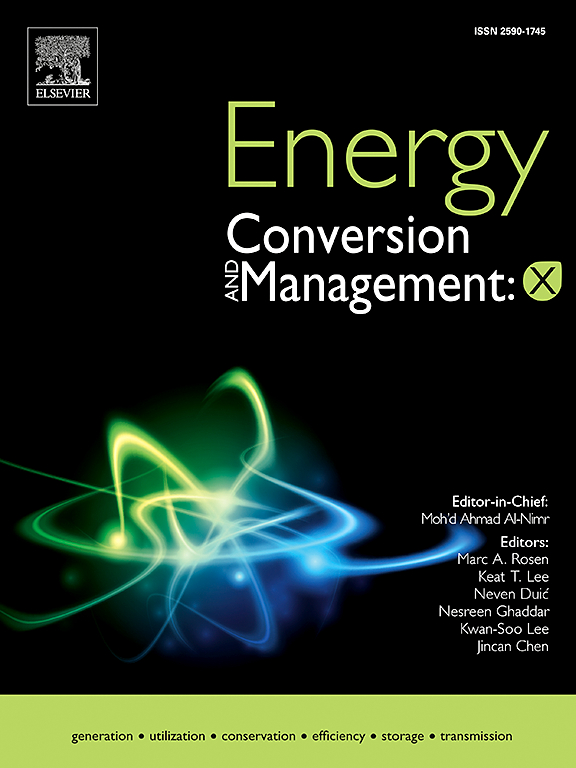IF 7.1
Q1 ENERGY & FUELS
引用次数: 0
摘要
利用有机郎肯循环 (ORC) 进行余热回收可提高能源效率、减少排放并降低成本。本研究使用 DWSIM 软件评估了用于高温余热回收(515.14 °C)的 ORC 系统。研究分析了各种 ORC 配置,包括简单 ORC (sORC)、串联 ORC (S-ORC)、单级再生 ORC (SR-ORC)、双级再生 ORC (DR-ORC) 和多蒸发压力 ORC (ME-ORC),以及不同的工作流体,包括甲苯、十二烷、苯和环戊烷。甲苯被确定为最佳工作流体,在 sORC 中实现了 24.33 % 的热效率和 1,839.66 kW 的净功率输出。S-ORC 性能优越,在相同效率下可输出 3,679.32 千瓦的净功率。参数研究考察了工作压力、废气温度和质量流量对效率的影响。结果显示,热效率在 40.08 巴时达到峰值,在废气温度为 520 °C 和质量流量为 44.5 kg/s 时性能最佳。热能分析表明,蒸发器是效率低下的主要原因,这为提高整个系统的效率提供了改进机会。在经济上,S-ORC 的净现值 (NPV) 为 398 万欧元,投资回收期为 5.75 年,内部收益率 (IRR) 为 12.66%。此外,每年还可减少 12,971.36 公吨的二氧化碳排放量,通过欧盟排放交易计划(EU ETS)下的碳信用额度交易,可获得 104 万欧元的收入。总之,S-ORC 配置为工业余热回收系统提供了热力学、经济和环境效益的最佳平衡。本文章由计算机程序翻译,如有差异,请以英文原文为准。
Thermodynamic, economic, and carbon emission evaluation of various Organic Rankine cycle configurations for maximizing waste heat recovery potential
Waste heat recovery using the Organic Rankine Cycle (ORC) enhances energy efficiency, lowers emissions, and reduces costs. This study evaluates ORC systems for high-temperature waste heat recovery (515.14 °C) using DWSIM software. Various ORC configurations, including simple ORC (sORC), series ORC (S-ORC), single-stage regenerative ORC (SR-ORC), double-stage regenerative ORC (DR-ORC), and multi-evaporating pressure ORC (ME-ORC), were analyzed with different working fluids, including Toluene, Dodecane, Benzene, and Cyclopentane. Toluene was identified as the best working fluid, achieving a thermal efficiency of 24.33 % and a net power output of 1,839.66 kW in the sORC. The S-ORC demonstrated superior performance, delivering 3,679.32 kW of net power at the same efficiency. A parametric study examined the effects of operating pressure, exhaust gas temperature, and mass flow rate on efficiency. Results showed thermal efficiency peaked at 40.08 bar, with optimal performance at an exhaust gas temperature of 520 °C and a mass flow rate of 44.5 kg/s. Exergy analysis identified the evaporator as the main source of inefficiency, highlighting opportunities for improvement to boost overall system efficiency. Economically, the S-ORC achieved a Net Present Value (NPV) of 3.98 million EUR, a payback period of 5.75 years, and an Internal Rate of Return (IRR) of 12.66 %. It also reduced CO2 emissions by 12,971.36 metric tons annually, translating to 1.04 million EUR in revenue through carbon credit trading under the EU ETS. In summary, the S-ORC configuration offers the best balance of thermodynamic, economic, and environmental benefits for industrial waste heat recovery systems.
求助全文
通过发布文献求助,成功后即可免费获取论文全文。
去求助
来源期刊

Energy Conversion and Management-X
Multiple-
CiteScore
8.80
自引率
3.20%
发文量
180
审稿时长
58 days
期刊介绍:
Energy Conversion and Management: X is the open access extension of the reputable journal Energy Conversion and Management, serving as a platform for interdisciplinary research on a wide array of critical energy subjects. The journal is dedicated to publishing original contributions and in-depth technical review articles that present groundbreaking research on topics spanning energy generation, utilization, conversion, storage, transmission, conservation, management, and sustainability.
The scope of Energy Conversion and Management: X encompasses various forms of energy, including mechanical, thermal, nuclear, chemical, electromagnetic, magnetic, and electric energy. It addresses all known energy resources, highlighting both conventional sources like fossil fuels and nuclear power, as well as renewable resources such as solar, biomass, hydro, wind, geothermal, and ocean energy.
 求助内容:
求助内容: 应助结果提醒方式:
应助结果提醒方式:


